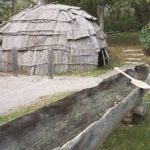We are moving deeply into November, the month now recognized as containing the National Day of Mourning for the Native Peoples of this land.
Looking wistfully for optimism, or something truthful about our history, a friend and I ventured to the Mashpee Wampanoag Indian Museum. We were rewarded with a display of handicrafts, both ancient and current.

But most remarkable was what we found when we headed out the back door of the building. There stood a wetu, a traditional Wampanoag structure — this one undergoing roof repairs.
Bending down to enter the large space with an open smoke hole above, we found ourselves enveloped in cedar saplings bent into a curved frame and barked with tulip poplar.
Baskets woven from local reeds sat on shelves, soft pelts upholstered benches, and a few utensils and tools were in view, items that would have been used for cooking and heating. The sense was of a cozy home, a space attended with care and craftsmanship.
And something else enveloped me there — a feeling that this was enough, that this was yesterday, today, and maybe tomorrow, all in one space.
Tribal leader David Weeden, who has studied and built these structures, explained during the Eastham 400 celebrations that the Wampanoag people built wetus for different seasons. This was a winter wetu, heavily covered with bark. Ash was the preferred covering for winter homes because it was both pliable enough to work and durable enough to support the heavy snows that were more common in earlier times.
The thick sheets of bark we observed in Mashpee, we learned, were imported from Maryland and Connecticut. But centuries ago, our own Cape Cod forests would have supplied them.
A well-insulated wetu can be kept at 75 to 80 degrees with only a small fire. These winter homes varied in size. We stood in a small one — a “one-fire house.” Weeden says people tended to live communally in the cold months, more likely in longer, two-fire houses.
The Wampanoags’ summer wetus, designed to provide shade and allow air to circulate, were sapling-framed too, but sheathed in reed mats instead of bark. Cattails swelled up nicely when it rained and shrank back when they dried out.
And so, our predecessors on this peninsula were seasonal people, too, migrating to these shores for summer fishing and gardening, for beaches to play on and water to swim in, and for shoulder season sunsets and oysters.
Then, as one Wampanoag elder explained this migration, “When the cold winds blew the dry leaves back to the earth, people would move inland where winters weren’t so harsh.”



